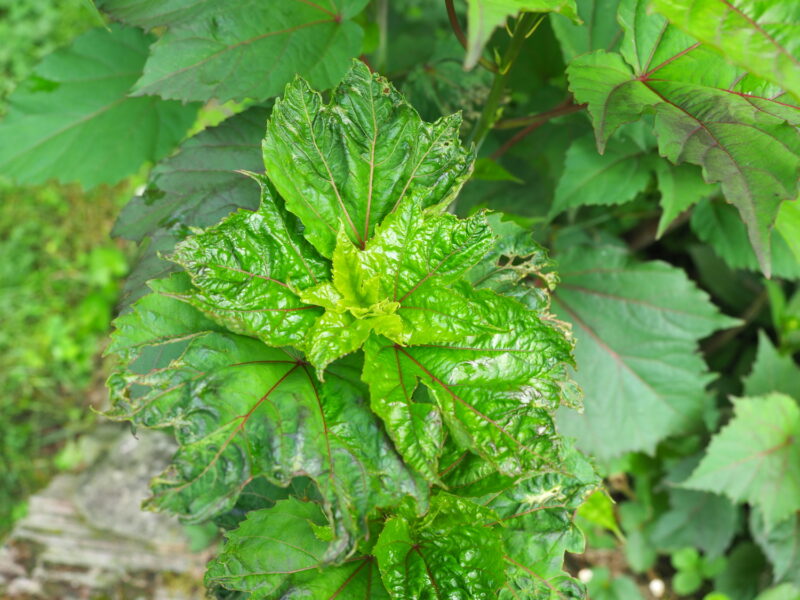

This is part two of a series on plant diseases that you may be afflicted with at this time of the year, but not before I mention that even horticulturists are not immune to attacks by the likes of powdery mildew.
About 15 winters ago I decided that my living room windowsills might be the perfect spot to begin growing African violets. Yes, it can now be told that I’d never grown African violets, so the time was long overdue. I went to a local greenhouse and picked out a few healthy specimens, and they did just great. That was until the day I realized that the powdery stuff on the foliage wasn’t pollen but powdery mildew.
I made a panicked call to my local plant pathologist who gave me even worse news: There wasn’t a thing I could do.
It seems that the microclimate created near the cool glass of the window that was hit with the warm and humid interior air of the living room was just what the dormant mildew spores needed to have a party — and so they did. But as winter ebbed, the problem solved itself with the introduction of an open window and plenty of fresh air. Unfortunately, as soon as the humidity and temperature were just right the violets were again doomed to mildewland.
Now, back to what may be your problems, and many will be on your veggies. Mosaic is a viral disease that you see most often on peppers, cucumbers and corn. The symptoms are a green and yellow mottling of the foliage and an overall stunting of the plant’s growth. Fruits may have light splotches and a warty appearance.
The best solution is to seek varieties that are resistant to this disease (the seed packet or plant tag will say so) but if you want to grow heirloom peppers that aren’t resistant then you’ll need to control aphids as again these insects are the vectors, or carriers, of the disease.
Late blight is a fungal disease that affects tomatoes and potatoes. The symptoms are dark, irregular spots on the leaves that are often accompanied by a white mold on the underside. Fruits and tubers can also be affected, especially in cool damp weather. Unfortunately, there is only one sure way to control this problem, and it is with regular use of fungicides. Good sanitation also helps, especially destroying any left-over crop residues and using healthy transplants or seed potatoes next year.
Bacterial blight is a disease that affects peas and beans. Water-soaked spots develop on pods, stems and leaves. During wet weather the spots enlarge and a creamy ooze may appear. In dry weather the spots dry up. During the winter the bacteria can make a home in seeds or crop residues. To control the problem, rotate crops, don’t use homegrown seed and don’t work amid wet foliage. Literature also indicates that seed produced in the western United States is much less prone to carry the problem.
Damping off is caused by soil-borne fungi that can affect all plants. The symptoms are poor germination, rotting of seeds and decaying of lower stem and roots on seedlings (which causes them to fall over) and lesions on roots or stems. Good drainage is essential in making sure that this problem isn’t yours, and sterile soil (as in peat-lite mixes) as well as clean flats and pots will help. Many seeds can be pretreated with a fungicide.
Fusarium wilt is also a fungal disease, and it affects tomatoes, potatoes, vine crops and others. It’s usually noticed as leaves begin to curl upward and wilt during the heat of the day, often recovering at night. In the later stages the plant wilts and never recovers, but don’t confuse this with the normal daytime wilting that tomatoes are prone to in the heat of the summer. Look for discoloration of a stem cutting as this is usually a foolproof sign, and expect to see this problem mostly in hot, dry weather. There are no chemical controls available, crop rotation seems to be of little value, but resistant varieties of seeds and plants are available.
Blossom end rot is a physiological disorder that affects tomatoes, peppers and eggplants. The typically affected plant yields fruits that have sunken, tough, black patches at the blossom end. It was discovered that the problem is caused by a calcium deficiency coupled with uneven moisture in the soil. If you have had this problem, it is easily corrected, but for next year’s crops. Mulch your soil to keep the ground evenly moist, avoid excessive use of high nitrogen fertilizers and add lime if your calcium levels show up low in a soil test.
Bacterial soft rot can be extremely frustrating because of the speed of infection and nearly complete destruction of fruits. The disease affects lettuce, onions, cabbage and other fruits and veggies. It first appears as small rot spots that rapidly enlarge and become soft and watery. Within three to five days the entire fruit is worthless slime. Again, there is no chemical control and good garden sanitation as well as good air circulation and drainage will help.
Finally, if you haven’t had enough, there is gray mold. This fungal disease affects lettuce, strawberries, flowers, onions, squash, eggplants and others. The symptoms appear as dark, water-soaked spots on leaves and stems. During humid weather, the fungus will appear as a gray mold on affected areas that quickly spreads to the whole fruit. The disease is a problem in cool, damp weather and can be controlled with crop rotation as well as fungicides.
So do you have the picture? If it’s hot and dry they get you one way, and if it’s cool and wet they get you the other. Good reason for the home gardener to be paranoid, but in fact a gardener with some experience under his or her belt can anticipate, plan and control these diseases to such a point that in most years they are little more than occasional nuisances. For beginners the secret is in identifying these problems, learning to plant resistant varieties and practice good garden sanitation.
Now it’s not all bad news. There are actually somewhat good viruses that result in some of the striations and variegations that we see in plant foliage. There are two natural enemies of the dreaded gypsy moth caterpillar. One is a virus called NPV and the other is a fungus called Entomophaga maimaiga. In very wet springs this fungus can become rampant among gypsy moth populations and decimate infestations to the point where they can virtually disappear even after several successive years of attack, as has happened out here in 2001-2002.
In last week’s column I promised a little treat for tomato growers. To take advantage of this treat you’ll need an iPhone or iPad. Go to the App Store and buy Tomato MD. The app was co-authored by Margery Daughtrey, Dan Gilrein, Margaret McGrath and others from Cornell’s Long Island Horticultural Research Farm in Riverhead. The pictures and descriptions of tomato issues on the various types of tomatoes may be very helpful. Keep growing.
Get a Diagnosis
Disease diagnosis can be very difficult for gardeners and can be very frustrating.
First go online and look for diseases (including pictures) on the plant in question. If it’s a valuable plant or widespread in the garden, you can take samples to the Cooperative Extension office in Riverhead (631-727-7850 ext. 11215) and for a fee they will either do the ID or send the specimen to the research lab for more analysis. Most treatments involve removing the infected plant or plant parts and or applying a pesticide.
For plant viruses, there are rarely cures or treatments. In all disease circumstances, your best defense is in buying plants known to be disease resistant. Remember that aphids are a prime transmitter of some diseases and several viruses. This is true of vegetables, turf grasses and ornamentals.
 More Posts from Andrew Messinger
More Posts from Andrew Messinger